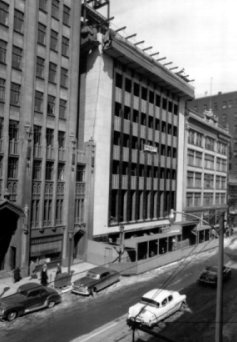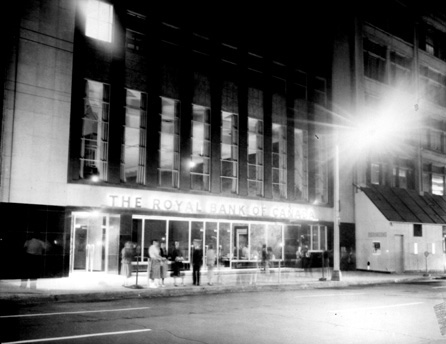28-32 James Street South
THE HEART OF THE CITY
ROYAL BANK
28-32 James Street South
CURRENT STATUS (1999)
Present Owner: Royal Bank
Present Use: Same
Heritage Status: N/A
Locally Significant Date: N/ABUILDING INFORMATION
Date Built: 1954
Original Owner: Royal Bank
Original Use: Same
Subsequent Uses: SameARCHITECTURE
Size: 6-storey
Architect, Builder: E.P. Warren
Design and Style: N/A
Construction Materials: Steel frame, limestone, black granite, brick
Main Architectural Feature: N/A
The Royal Bank, one of the largest Canadian financial institutions, traces its banking history back to 1885 when the Traders Bank of Canada, which would later merge with the Royal Bank, opened in Hamilton. The Royal Bank itself began operations here in 1903 with a branch at Barton and Wentworth Streets. In 1912, the two banks merged and Royal Bank took over the latter's branch office, which was located at 17-19 King Street West. It remained in this location until 1956. In 1926 the Royal Bank took over two Union Bank of Canada branches.
 In January of 1921, a branch of the Royal Bank located at 21 King Street West
was almost completely gutted by fire. The offices in the building were badly affected by
fire, water, and smoke, and the building was deemed untenable. Many valuable documents,
books and currency were protected from the heat of the flames by the vaults. The flames
were so intense that clouds of smoke blanketed the area and the city was covered by a
thick haze. Many fire hydrants were blocked by several parked cars thereby preventing
attachment of the hoses and several firemen were overcome by fumes and carried from the
building. It was believed that large quantities of stationary which were being stored in
the basement, caused great quantities of smoke to billow from the building. Damage to the
structure alone was estimated at $50,000. The building was occupied by the Royal Bank on
the main floor and basement, Dr. J.A. Locheed, dentist, The Lion Tire and Rubber Company
on the second floor and the Tiger Club on the third floor. Other businesses to suffer
damage were The Grange Café, Lees Jewellery Shop and the Herald Printing Company.
In January of 1921, a branch of the Royal Bank located at 21 King Street West
was almost completely gutted by fire. The offices in the building were badly affected by
fire, water, and smoke, and the building was deemed untenable. Many valuable documents,
books and currency were protected from the heat of the flames by the vaults. The flames
were so intense that clouds of smoke blanketed the area and the city was covered by a
thick haze. Many fire hydrants were blocked by several parked cars thereby preventing
attachment of the hoses and several firemen were overcome by fumes and carried from the
building. It was believed that large quantities of stationary which were being stored in
the basement, caused great quantities of smoke to billow from the building. Damage to the
structure alone was estimated at $50,000. The building was occupied by the Royal Bank on
the main floor and basement, Dr. J.A. Locheed, dentist, The Lion Tire and Rubber Company
on the second floor and the Tiger Club on the third floor. Other businesses to suffer
damage were The Grange Café, Lees Jewellery Shop and the Herald Printing Company.
In June of 1954, the bank decided to erect a new branch on James Street South at an estimated cost of $2,000,000. The company purchased the premise that was formerly occupied by the Spectator and hired Cooper Wrecking Company of Dundas to demolish the building. Architect E.P. Warren of Montreal designed the new six-storey building that was to house the bank. The frontage measured 76 feet wide and 185 feet deep. The façade of the building was constructed of native black granite trimmed with Queenston limestone with brick sides and back. The frame was constructed of steel and the building was equipped with elevators, air-conditioning, and basement parking. The steel for the project was provided by Dominion Bridge Company, the metal form by Robert Irwin Company of Hamilton, the limestone was given by The Canada Crushed Stone Company, and glazing was provided by the Hobbs Glass Division of Pittsburgh.
The opening of the new branch on James Street South was held on January 28, 1956. The interior of the bank was decorated in brown tones set off by high windows framed in turquoise shaded Quebec marble. The upholstery was turquoise and brightened the more subdued tones. The main floor was carpeted in a soft rosy beige, and the walls were mirrored from floor to ceiling. An article in the Spectator dated January 25, 1956 described the new location as representing "a major contribution to the multi-million program of new construction and modernization of banking and trust companies building business premises which has given a new look to this part of downtown Hamilton in the last two years." The main banking room measured 66 by 183 feet. The noisemakers (all the bookeeping machines and other mechanical equipment) were kept on the mezzanine floor, while pneumatic tubes carried correspondence, figures and statements back and forth to the banking floor.
 An
article in the Journal of the Royal Architectural Institute of Canada described the Royal
Bank's new standards for their branches. The new buildings erected varied in size from
small to imposing, and were of a contemporary design. It was common that large areas of
glass, light metal and finished masonry surfaces of stone, granite or marble were
generally used with the emphasis placed on light, air and similar amenities. The dull
colour shades of days gone by gave way to a highly planned interior colour scheme in which
special walls were highlighted by different shades or contrasting materials. The
contemporary design of the interiors encompassed enriched and enlivened colours, which
were exhibited in the arrangement of the floor and ceiling. The design of the counters and
counter fittings has also changed from the days when heavy grilles and metal meshwork were
in style for the teller’s cages. The accent in the modern bank was placed on low line
counters and unobtrusive grilles that conformed to the needs of banking practices. The
Royal Bank enclosed the teller's cages with protective glass. The bank was also concerned
with providing adequate parking facilities for its customers.
An
article in the Journal of the Royal Architectural Institute of Canada described the Royal
Bank's new standards for their branches. The new buildings erected varied in size from
small to imposing, and were of a contemporary design. It was common that large areas of
glass, light metal and finished masonry surfaces of stone, granite or marble were
generally used with the emphasis placed on light, air and similar amenities. The dull
colour shades of days gone by gave way to a highly planned interior colour scheme in which
special walls were highlighted by different shades or contrasting materials. The
contemporary design of the interiors encompassed enriched and enlivened colours, which
were exhibited in the arrangement of the floor and ceiling. The design of the counters and
counter fittings has also changed from the days when heavy grilles and metal meshwork were
in style for the teller’s cages. The accent in the modern bank was placed on low line
counters and unobtrusive grilles that conformed to the needs of banking practices. The
Royal Bank enclosed the teller's cages with protective glass. The bank was also concerned
with providing adequate parking facilities for its customers.
In recent years, the split-level branch had become quite common, especially in locations where the space was confined. The two-floor branch was achieved by reducing the depth of the basement area, and having the ground floor level about six steps above the sidewalk. Under this arrangement, there was enough natural lighting for the banking room, accessible by the short stairway.
 The Royal Bank was no stranger to undesired guests. From bank robbers to
reptiles the bank has seen it all. On August 8, 1957, an alligator was found swimming atop
the roof of the James Street Royal Bank. Workmen were called to do some repairs on the
roof which was kept flooded to a depth of 5 to 6 inches to prevent the tar from bubbling
up. Unbeknownst to the workmen, an alligator was trapped on the roof. No one knew how or
why it was there. The reptile was rescued without incident. The roof was also home to
numerous goldfish that were placed in the water by the workmen. Interestingly enough, the
gold fish were not harmed by the alligator, they merely kept him company during his
ordeal.
The Royal Bank was no stranger to undesired guests. From bank robbers to
reptiles the bank has seen it all. On August 8, 1957, an alligator was found swimming atop
the roof of the James Street Royal Bank. Workmen were called to do some repairs on the
roof which was kept flooded to a depth of 5 to 6 inches to prevent the tar from bubbling
up. Unbeknownst to the workmen, an alligator was trapped on the roof. No one knew how or
why it was there. The reptile was rescued without incident. The roof was also home to
numerous goldfish that were placed in the water by the workmen. Interestingly enough, the
gold fish were not harmed by the alligator, they merely kept him company during his
ordeal.
An article from the Spectator dated August 5, 1960 reported on the new vaults installed by the Royal Bank. The management and staff were more than confident that their massive vault was burglar proof. The description given by the paper was rather detailed and included pictures of the vault. There were three doors leading to the vault which were made of inch-thick steel bars. Behind the last door there was an office where clerical work and money counting was done. Before anyone was permitted to pass through the doors, they had to be identified. Between the office and the entrance door there was a thick bulletproof steel wall to prevent robberies. The safe door weighed in excess of ten tons and was over one foot thick having three locks which were made of alloy. There was also an employee who worked in the safe all day long, checking the money. That year, the successful bank boasted of owning and operating twelve branches in Hamilton, three in Burlington and one each in Dundas, Waterdown and Stoney Creek.
On April 9, 1976 the Royal Bank at Merrick and Park Streets, formerly known as the Market Branch, announced that it was moving to new quarters located at Bay and Merrick Streets, in the former UniRoyal Tire Store. The Merrick branch was one of the smallest banks in the city having a staff of only fourteen. It began in 1903 at MacNab on the corner of York. The bank was located on the corner where the two streets joined in a narrow sliver of buildings just across from the Farmer’s Market. This location disappeared with the Urban Renewal Projects. The Bank moved to Merrick and Park Streets in 1972 where it remained for only four years.
In October of 1987 the Royal Bank announced that it was opening three independent
business centres, an operations centre and a new branch. The independent business centres were located at
James Street South, the Centre Mall and Grays Road near Highway 8. The operation centre,
which was designed to centralize paperwork from branches in the Hamilton-Wentworth and
Brantford regions, was located at Barton near Highway 20. The new branch was located at
Upper Wentworth. An executive account management office was opened in the main branch. The
following year, Royal Bank called for the expansion of its James Street headquarters.
Approximately $2,000,000 was allocated for the expansion operation. On November 15, 1988
it was announced that the regional centre in downtown Hamilton intended to provide a team
of experts to serve businesses with $500,000 or more line of credit. "By
specializing, you become more in tune with the customer's needs, the business climate and
services available in the marketplace." The need for specialization arose because of
the growing presence of foreign banks, trust companies, and credit unions which have
combined to create a more competitive atmosphere. The bank purchased the former Robinson's
store next to its James Street branch for an undisclosed amount in 1989.
centre and a new branch. The independent business centres were located at
James Street South, the Centre Mall and Grays Road near Highway 8. The operation centre,
which was designed to centralize paperwork from branches in the Hamilton-Wentworth and
Brantford regions, was located at Barton near Highway 20. The new branch was located at
Upper Wentworth. An executive account management office was opened in the main branch. The
following year, Royal Bank called for the expansion of its James Street headquarters.
Approximately $2,000,000 was allocated for the expansion operation. On November 15, 1988
it was announced that the regional centre in downtown Hamilton intended to provide a team
of experts to serve businesses with $500,000 or more line of credit. "By
specializing, you become more in tune with the customer's needs, the business climate and
services available in the marketplace." The need for specialization arose because of
the growing presence of foreign banks, trust companies, and credit unions which have
combined to create a more competitive atmosphere. The bank purchased the former Robinson's
store next to its James Street branch for an undisclosed amount in 1989.
In 1991, Royal Bank launched a Business Banking and Technology Showcase which provided explanations of the Bank's services. Experts described the latest in electronic data interchange, international trade, electronic business banking, Visa point-of-sale equipment, private banking and treasury service to all inquiring customers. In February of 1992, the Royal Bank's first full service branch to be located in a grocery store opened in the Miracle Ultra Mart Store on Fairview Street in Burlington.
That same year, the financial giant became the first bank in Canada to offer Braille Statement services to their visually impaired clients at no extra charge.
The Royal Bank as many other financial institutions has, throughout its history, been hit by waves of crime, characterized by a series of robberies. In some incidents, the staff and customers were herded into the vault while other times, limping bank robbers threw bombs on the floor.The 1980s and the early part of the 1990s proved to be an intense period of robberies for the bank.
From 1982 to 1990, the Royal Bank was hit by over a dozen robberies involving various locations from all areas of the City. 1990 proved to be the year of bank robberies for the City of Hamilton. As quoted by the Spectator: "More banks and other financial institutions have been robbed in Hamilton so far this year than in all of 1989".
Not all robberies were disastrous for the bank. In 1992, "Two hapless robbers, one armed with a handgun, should have done a little more research before storming into the Royal Bank on Upper James and Mohawk Road early Saturday, set for their big heist. They quickly discovered they'd picked the wrong bank. That branch had cash available only in automated tellers on Saturday."

In May of 1994 it was announced that the Royal Bank’s mortgage administration centre in Hamilton was moving to Toronto as part of a corporate restructuring. Jobs were not lost, merely transferred to Toronto.
The bank was also plagued by internal theft and human error. In 1995, a former Royal Bank supervisor was charged with embezzling more than $1,500,000 from business accounts over a seven-year period (1988-1995) at the Royal Bank on James Street South. On June 4, 1997, the Spectator reported that the employees of the Centre Mall branch were in a hurry to get to an awards dinner and forgot to lock the back door of the bank on their way out. Police found the door open at approximately 6 p.m. and called the alarm company. Upon discovering that the employees were at the Renaissance Banquet Centre on Barton Street East near Nash Road, a cruiser was dispatched to pick up the employee with the key. The bank was then locked.
Over the years and still today, the Royal Bank has helped many entrepreneurs start up and expand their businesses. The Royal Bank of Canada provides a wide range of services both for personal and commercial banking, wealth management and corporate investment banking services on an international basis. This bank continues today in its service to the financial health to the Canadian community and the global economy.
See also: www.royalbank.com
REFERENCES: